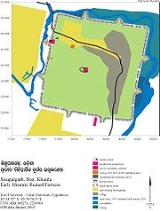
Sisupalgarh
Encyclopedia

Orissa
Orissa , officially Odisha since Nov 2011, is a state of India, located on the east coast of India, by the Bay of Bengal. It is the modern name of the ancient nation of Kalinga, which was invaded by the Maurya Emperor Ashoka in 261 BC. The modern state of Orissa was established on 1 April...
, India
India
India , officially the Republic of India , is a country in South Asia. It is the seventh-largest country by geographical area, the second-most populous country with over 1.2 billion people, and the most populous democracy in the world...
. It is the largest and best preserved early historic fortification in India.
Description
The remains of the ancient city Sisupalgarh has been discovered near Bhubaneswar, capital of the Orissa state in India. Sisupalgarh is a nationally protected monument. Archaeologists claim the city to be at least 2,500 years old. On the basis of the architectural pattern and artefacts discovered during the early excavations, B.B. Lal concluded that this fort city flourished between 3rd century BC and 4th century AD. On the basis of the new findings, M. Smith and R. Mohanty claim that the fortified city flourished from around 5th century BC and probably lasted well after the 4th century. Thus, this defensive settlement originated prior to the Mauryan empire. The population of the city could have amounted to 20,000 to 25,000. Archaeologists have employed geophysical survey, systematic surface collections and selected excavations in the 4.8 km perimeter of the fortified area and studied individual houses and civic as well as domestic architecture to arrive at the figure. The significance of the population is clear when one bears in mind that the population of classical Athens was 10,000. However the historians also claim that it is too early to comment on the population of the city as yet only a part of the city has been excavated.The first excavations at the site were carried out by B.B. Lal in 1948.
An American-Indian team took up work in 2001.
In 2005 ground penetrating radar revealed the probable position of the southern moat
Moat
A moat is a deep, broad ditch, either dry or filled with water, that surrounds a castle, other building or town, historically to provide it with a preliminary line of defence. In some places moats evolved into more extensive water defences, including natural or artificial lakes, dams and sluices...
. Toward the centre of the fortress (Area D) the 19 column structure has been recorded three-dimensionally by means of a laser scanner. It is disturbed and incomplete. Each of the glacis
Glacis
A glacis in military engineering is an artificial slope of earth used in late European fortresses so constructed as to keep any potential assailant under the fire of the defenders until the last possible moment...
of the quadrangular plan is pierced by two gates.
As at contemporary Jaugada
Jaugada
This site was first documented in 2001 by a team from the University of Heidelberg.'-References:Paul Yule, Early Historic Sites in Orissa ISBN 81-89645-44-7...
, the plan tips 10° clockwise of north. With 1125 m x 1115 m (measured on the crest) Sisupalgarh is larger in surface than is Jaugada. Sisupalgarh's defences are the highest known of this period in India. The gates themselves measure over 90m in length from the inside to outside and vary considerably in size, shape and in details of building. The western of the two gates in the northern glacis seems to be the largest and/or best preserved. The two in the southern glacis are the smallest. But as year for year the encroaching rice paddies increase in size, these and the other gates decrease in size. Excavation facets in the gate structures can be seen from the windows of commercial aircraft which pass by Sisupalgarh on the way in and out of Bhubaneswar
Bhubaneswar
Bhubaneswar is the capital of the Indian state of Orissa, officially Odisha. The city has a long history of over 2000 years starting with Chedi dynasty who had Sisupalgarh near present-day Bhubaneswar as their capital...
. The ancient settlement probably was not dense, but rather there was room inside the fortress to graze.


Preservation of the remains
In Lal's day this site was wildernis. The major portion of the land that constitutes the ancient city is in private possession hindering archaeological study. Since the site is nationally protected, it lies within the bailiwick of the Archaeological Survey of India.In 2006 the Indo German team made numerous drawings and a 3D scan of the column complex in order to document the preservation. This scan was then animated. The team also documented that considerable illegal building accelerated in 2005 on this nationally protected site
The well-known historian Karuna Sagar Behera has voiced serious concern over the preservation of material unearthed from the site and notes, "It is a shame that some gold coins and terracotta pottery found at the place during the first excavation in the late 1940s were subsequently lost."

